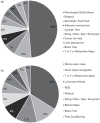Variability of functional outcome measures used in animal models of stroke and vascular cognitive impairment - a review of contemporary studies
- PMID: 30203705
- PMCID: PMC6259321
- DOI: 10.1177/0271678X18799858
Variability of functional outcome measures used in animal models of stroke and vascular cognitive impairment - a review of contemporary studies
Abstract
Despite promising preclinical data, few novel stroke therapies have shown efficacy in man. Efforts to improve standards in conduct and reporting of preclinical research are ongoing. In clinical trials, inconsistency in outcome measures led to regulatory agencies and funders mandating use of a core set of functional outcomes. Our aim was to describe functional outcome measures in preclinical stroke and vascular cognitive impairment (VCI) studies. From 14 high impact journals (January 2005-December 2015 inclusive), 91,956 papers were screened with 1302 full texts analyzed for stroke (ischemic and hemorrhagic) and 56 for VCI studies. In total, 636 (49%) stroke and 37 (66%) VCI papers reported functional outcome measures. There were 74 different functional assessments reported in stroke and 20 in VCI studies. Neurological deficit scores (74%) and Morris water maze (60%) were most commonly used in stroke and VCI, respectively. However, inconsistencies in methods used to assess and score recovery were noted. Neurological and behavioural functional outcome measures are increasingly used in preclinical stroke or VCI studies; however, there is substantial variation in methods. A strict standardized outcome set may not be suitable for translational work, but greater consistency in choice, application and reporting of outcomes may improve the science.
Keywords: Rodent; functional outcome measure; hemorrhagic stroke; middle cerebral artery occlusion; vascular cognitive impairment.
Figures






Similar articles
-
Neuropsychological assessment and cerebral vascular disease: the new standards.Rev Neurol (Paris). 2013 Oct;169(10):779-85. doi: 10.1016/j.neurol.2013.07.009. Epub 2013 Aug 30. Rev Neurol (Paris). 2013. PMID: 23999023 Review.
-
The current situation on vascular cognitive impairment after ischemic stroke in Changsha.Arch Gerontol Geriatr. 2014 Mar-Apr;58(2):236-47. doi: 10.1016/j.archger.2013.09.006. Epub 2013 Oct 6. Arch Gerontol Geriatr. 2014. PMID: 24148887
-
Vascular cognitive disorders and depression after first-ever stroke: the Fogarty-Mexico Stroke Cohort.Cerebrovasc Dis. 2014;38(4):284-9. doi: 10.1159/000366471. Epub 2014 Nov 20. Cerebrovasc Dis. 2014. PMID: 25412708
-
Trial design and reporting standards for intra-arterial cerebral thrombolysis for acute ischemic stroke.Stroke. 2003 Aug;34(8):e109-37. doi: 10.1161/01.STR.0000082721.62796.09. Epub 2003 Jul 17. Stroke. 2003. PMID: 12869717
-
Clinical presentations and epidemiology of vascular dementia.Clin Sci (Lond). 2017 Jun 1;131(11):1059-1068. doi: 10.1042/CS20160607. Clin Sci (Lond). 2017. PMID: 28515342 Review.
Cited by
-
Comparative Assessment of Manual Segmentation of Cerebral Infarction Lesions in Experimental Animals Based on Magnetic Resonance Imaging Using Artificial Intelligence.Bull Exp Biol Med. 2025 Feb;178(4):514-519. doi: 10.1007/s10517-025-06366-2. Epub 2025 Mar 28. Bull Exp Biol Med. 2025. PMID: 40148667
-
dl-3-n-butylphthalide preserves white matter integrity and alleviates cognitive impairment in mice with chronic cerebral hypoperfusion.CNS Neurosci Ther. 2019 Sep;25(9):1042-1053. doi: 10.1111/cns.13189. Epub 2019 Jul 23. CNS Neurosci Ther. 2019. PMID: 31334611 Free PMC article.
-
Notoginsenoside R1 for Organs Ischemia/Reperfusion Injury: A Preclinical Systematic Review.Front Pharmacol. 2019 Oct 17;10:1204. doi: 10.3389/fphar.2019.01204. eCollection 2019. Front Pharmacol. 2019. PMID: 31680976 Free PMC article.
-
UK consensus on pre-clinical vascular cognitive impairment functional outcomes assessment: Questionnaire and workshop proceedings.J Cereb Blood Flow Metab. 2020 Jul;40(7):1402-1414. doi: 10.1177/0271678X20910552. Epub 2020 Mar 9. J Cereb Blood Flow Metab. 2020. PMID: 32151228 Free PMC article.
-
Polypathologies and Animal Models of Traumatic Brain Injury.Brain Sci. 2023 Dec 12;13(12):1709. doi: 10.3390/brainsci13121709. Brain Sci. 2023. PMID: 38137157 Free PMC article. Review.
References
-
- O'Collins VE, Macleod MR, Donnan GA, et al. 1,026 Experimental treatments in acute stroke. Ann Neurol 2006; 59: 467–477. - PubMed
-
- STAIR. Recommendations for standards regarding preclinical neuroprotective and restorative drug development. Stroke 1999; 30: 2752–2758. - PubMed
-
- Macleod MR, Fisher M, O'Collins V, et al. Good laboratory practice: preventing introduction of bias at the bench. Stroke 2009; 40: e50–52. - PubMed
Publication types
MeSH terms
Grants and funding
LinkOut - more resources
Full Text Sources
Other Literature Sources
Medical

